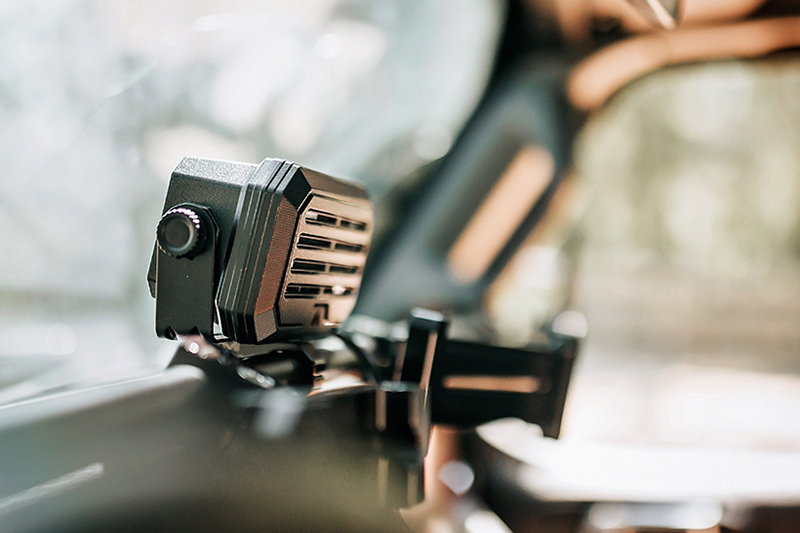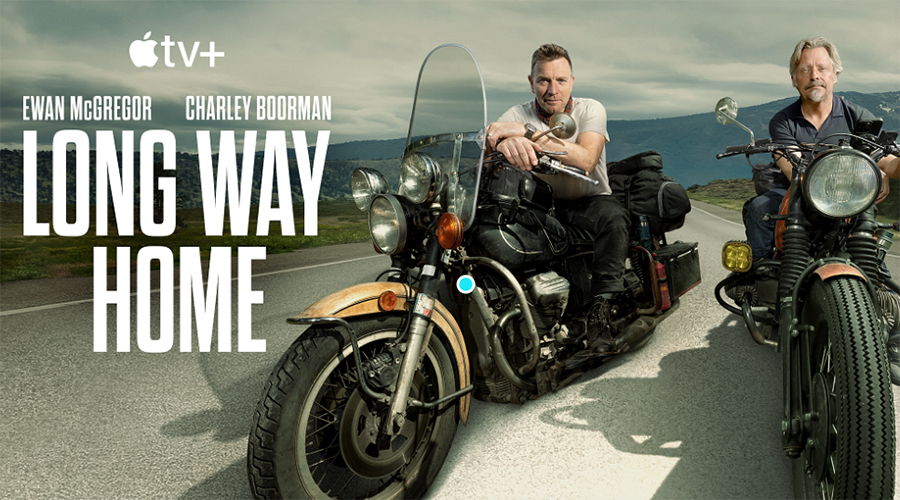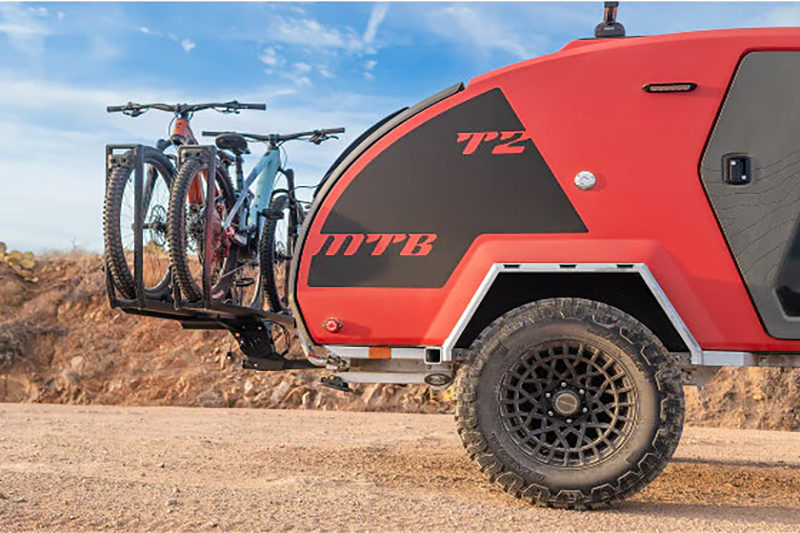Palo Duro Canyon is the second largest canyon in the United States and is home to some of the finest mountain biking east of Moab
Close your eyes and imagine a place where indigenous peoples battled each other while thriving off the land for nearly 12,000 years. A place carved from the basement of time. A place so unique to its surroundings that it’s almost surreal. Now, open your eyes and look around you. Walls as deep as an 80-story building with layers of jagged white gypsum and soft red claystone surround you. You’re in the middle of a geological time capsule. You’re in Palo Duro Canyon.
Palo Duro Canyon resides in the panhandle of west Texas and stretches along the Llano Estacado, an area encompassing nearly 38,000 square miles of the south plains. At 120 miles in length, the canyon is the second largest in the United States. Much of its length falls within privately owned land, most of which was acquired via land grants during the great westward expansion more than 150 years ago. But not all the canyon is privately owned. Nestled within the northernmost section is Palo Duro Canyon State Park, established in 1934 by the Texas Parks and Wildlife Department and a true gem for adventurous spirits, with a myriad of recreational opportunities including camping, hiking, mountain biking, horseback riding, and wildlife viewing.
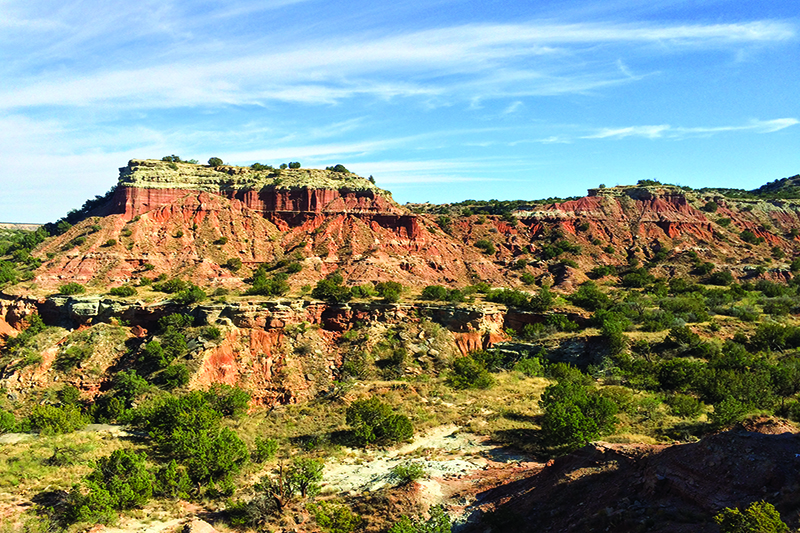
Layers of red sandstone and gypsum comprise Palo Duro Canyon’s walls
My recent outing to Palo Duro Canyon wasn’t my first. Over 20 years prior, I was introduced to Palo Duro Canyon as a college student at Texas Tech in nearby Lubbock, traveling to the canyon with friends for a weekend of primitive camping and hiking. Over the following years, until my graduation from college, I would make numerous trips to “PD,” as it was affectionately called, to explore the park’s immense history and enjoy its natural beauty on foot and by mountain bike. I developed a fondness for the park, a sort of friendship I carried with me, eventually guiding me along the path less traveled and into my career as a publisher. Once I graduated from school and left west Texas, I rarely went back, as if I had closed that chapter in my life.

Capitol Peak looms in the background
I didn’t return until eight years later, this time with my future wife, Andrea, to attend a Jeep Jamboree on privately owned land within the canyon. My reunion with this region was much like seeing a dear friend with whom I’d lost contact. It was as if the land and I picked up where we had left off, sharing the stories we had accumulated while we had been apart. It was good to be back and in some way, I felt like the canyon was happy I was there.
Along the way, Andrea and I had the opportunity to explore a region of the canyon I’d never seen, owned by a gentleman named Tom Christian, whose family had owned a large portion of the canyon since the mid-1800s. Mr. Christian spent a large portion of his early life serving in the Texas state legislature; his charm and knowledge of the land, and his contributions to the region and the state park, left an indelible impression on us. When he told us a portion of his land was used in the filming of several scenes from Indiana Jones and the Last Crusade, it only added to the canyon’s allure. We went on to enjoy a weekend of off-pavement adventure in my Jeep TJ Rubicon as well as in the state park by foot and mountain bike. PD left a lasting impression.

Stay on Trails and follow Leave No Trace and Tread Lightly! principles
Fast forward to today. For several months I’d had a yearning to get away and “recharge” for several days without life’s daily distractions. I needed a break and wanted to get back on my mountain bike. As I began developing a plan of when and where to go, the idea of going back to “PD” crept into my mind as if the canyon were whispering to me, nudging me to pay it a visit. Almost immediately I decided to return to Palo Duro Canyon and began planning the trip, mapping the route and packing as minimalist as possible, particularly since I was going solo. I was excited to keep it simple.

The Lighthouse in Palo Duro Canyon
Prior to my arrival at PD I had planned to ride two specific trails: The Lighthouse Trail, a multi-use trail for mountain biking, hiking and horseback riding – also my first foray in the park more than 18 years before – and the Capitol Peak Mountain Bike Trail, a challenging four-mile stretch of singletrack widely acknowledged as a cousin to the world-class mountain biking found in Moab. Singletrack, where the trail is only wide enough for one bicycle at a time, is a thrill to ride because it forces your senses to be on full alert; you never know what’s around the next curve.
My journey to PD took me through a large portion of the Lone Star State. Texas is an anomaly; its terrain is as varied as the people who reside here. The Gulf Coast lies on one end of the state and mountainous desert resides at the other, with forests, hills, and everything else ensconced between the two. This is what makes Texas such a unique place to visit: It has just about every type of terrain you can imagine and despite most of the land being privately owned, the state parks system is quite remarkable.
When I arrived at the entrance to Palo Duro Canyon State Park I slowly wound my way down the curved entrance road to the bottom of the canyon, until I eventually arrived at the gravel parking lot serving the trailhead to the Lighthouse Trail.

Near the trailhead of the Lighthouse and Capitol Peak Trails
The Lighthouse is the most popular trail in the park and for good reason. At the end of the trail towers a natural claystone formation standing 310 feet tall, acting as a guardian for the canyon. The journey to the Lighthouse is moderately difficult but it’s well worth the 5.75 miles to get there and back. Since the Capitol Peak Mountain Bike Trail can be accessed within the first mile of travel en route to the Lighthouse, I opted to first complete the journey to the Lighthouse, return to the gravel parking lot for lunch, then head back on the trail to complete the 4-mile roundtrip along the Capitol Peak Trail.
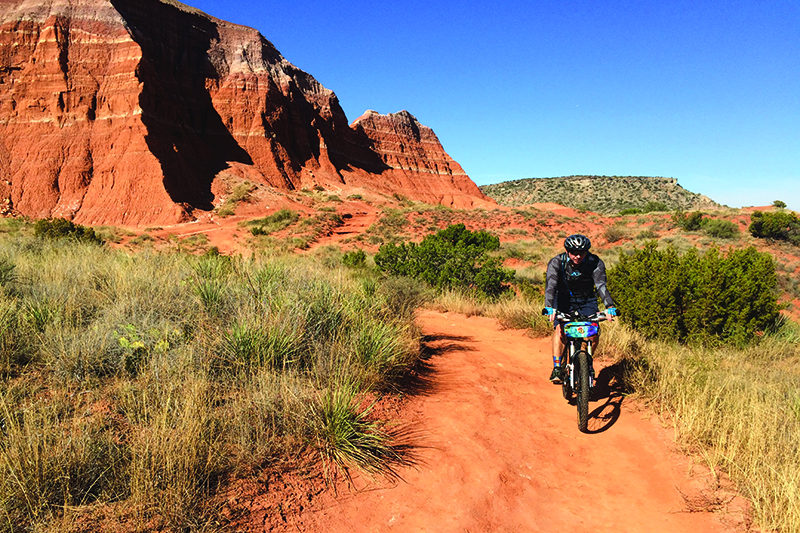
In the saddle
After doing a final inspection of my bike, a 2005 Ellsworth Truth with front and rear adjustable suspension, I loaded up my Carsick Designs Barrel Bag and CamelBak with my map, tools, spare tire tubes, energy snacks, plenty of water and other miscellaneous items, and took off! The feel of the rubber meeting the red claystone where the pavement ends and meets the trailhead was thrilling. I tore off like a man possessed, hopping over small boulders and pedaling hard along the 18% incline, winding back and forth and meeting several nice people along the way. The weather was perfect and, since it was the beginning of the week, there was very little traffic along the way. I stopped along the trail on several occasions to enjoy the beauty of my surroundings. It’s one thing to read about the geological history of a place like Palo Duro Canyon but it was overwhelming to see it in person and to have had it be a part of me for so long, then return to take it all in. Eventually I made it to the end of the trail, marked with a large sign that actually reads “End of Trail” near a picnic table in the shade. I continued along the optional hiking trail to the left of the picnic table to get close to the Lighthouse, as it’s not visible from the end of the trail. After a vertical ascent of approximately 170 feet and an additional quarter-mile to the Lighthouse, you’re rewarded with some of the most amazing views in all the state of Texas save for those seen along the South Rim at Big Bend National Park at sunrise (see Issue 15 to read about Big Bend). Once I arrived at my goal, I surveyed the canyon from a rock ledge. In the canyon’s embrace, I felt energized and as much in awe at seeing the Lighthouse as I had been the first time I saw it. Eventually I hopped onto my bike and wound my way back along the route I had traveled, refueled, then took off for the Capitol Peak Mountain Bike Trail.
The Capitol Peak Mountain Bike Trail is designed specifically for mountain biking. Hiking and horseback riding are not allowed on this trail. I had not done this trail before and after little more than a mile, I began to feel the burn of using my low gears to climb, drop, climb, drop, then climb again. It was brutal but like the Lighthouse Trail, the views motivated me to push on and I could almost hear the park urging me to pedal hard and push forward. Near the end was a small, manmade bridge and near there a rest stop where I propped my bike and gazed in awe at Capitol Peak. You can see it quite clearly after the first mile on the Lighthouse Trail but seeing it along this path rewards those who finish the trail. It’s a fantastic view that solidifies how remarkable this park truly is.
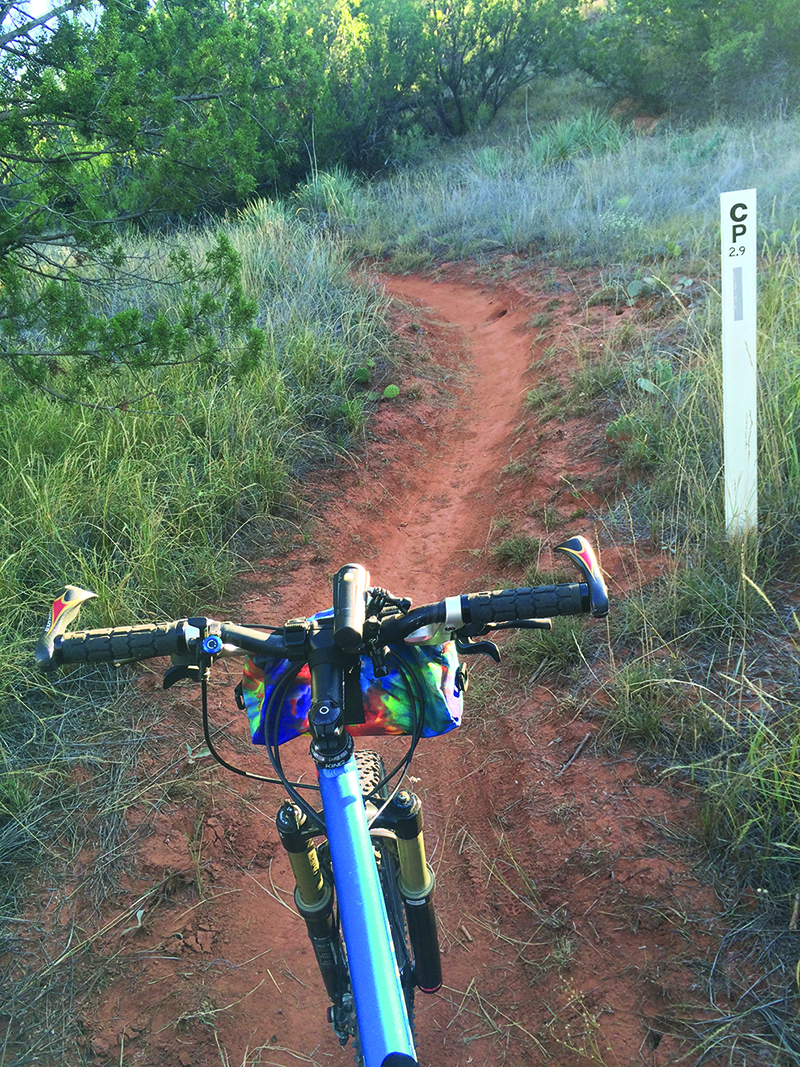
Taking a break along the Capitol Peak Mountain Bike Trail
I hopped back on the saddle and pedaled my way back to the gravel lot where my day had begun. After loading my bike and stopping at a nearby camping area to shower and pack up, I followed the winding road back toward the park entrance and stopped one last time at an overlook to say goodbye. I could imagine along a plateau, far off in the distance, a young native on horseback looking down into the canyon, searching for buffalo to feed his family. I imagined what it was like to see a fast-forwarded recording of the earth eroding from wind and water to form the canyon walls. I smiled and remembered my first jaunt to this park as a college student, seeing the canyon for the first time. My reunion was complete and my soul recharged and as I said my last goodbye to Palo Duro Canyon, I promised her that someday down the road, I would return.
Planning Your Palo Duro Canyon Adventure
How to get there:
Palo Duro Canyon is located approximately eight miles east of Canyon, Texas, a small town about 15 miles south of Amarillo, which is situated on Interstate 40.

An overview of Palo Duro Canyon State Park
When to go:
Texas in the summer is very hot. It’s best to visit PD, and anywhere in Texas for that matter, in the mid to late spring or mid to late fall. Flash floods do occur on occasion in PD but, despite this, there are usually burn bans in effect. Be sure to contact the park office before arrival to confirm any issues beforehand.
What to bring, what to do and miscellaneous information:
With the variety of adventure activities within the park including hiking, backpacking, mountain biking, horseback riding and wildlife viewing –- yes, there is wildlife including wild turkey and mule deer –- the gear you bring will depend on what you intend to do. I suggest a light daypack with sunscreen, pocket knife, headlamp, energy snacks, multiple water bottles and water, Epi-pen (if you have allergies including bees and wasps), and bicycle tools including spare tubes.
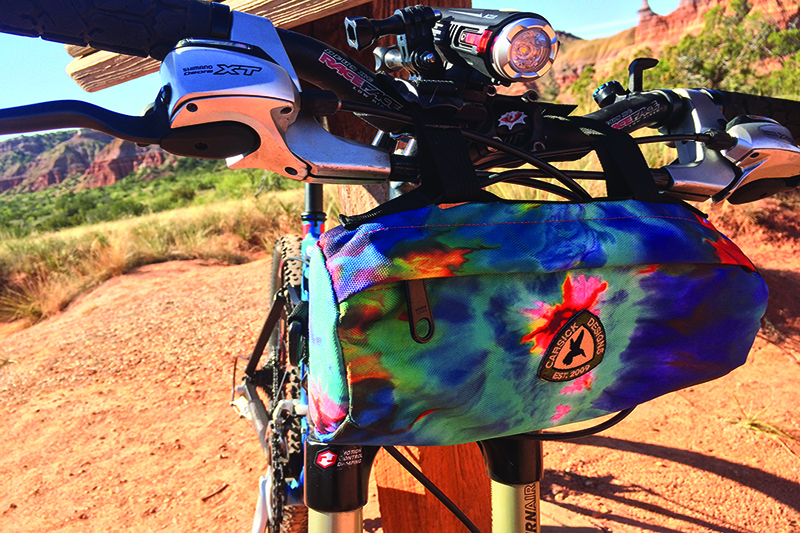
My Carsick Designs bag keeps my small items stored while I’m on the trails
The park also hosts several musicals at Pioneer Amphitheater including the outdoor musical “Texas” during the summer. Dinner is available prior to the show and visitors can enter the park without paying an entrance fee after 4 p.m. Park fees are $5 for adults, free for children (12 and under) and there are various opportunities for camping within the park including cabins (available with advance registration), car camping, primitive camping (tent only) and backcountry permits (by foot only). Unfortunately, there is no off-road travel within the park though nearby Elkins Ranch offers guided Jeep tours varying in length from 1-3 hours.
Additionally, the Merus Adventure Park in nearby Claude features over 5,500 acres of pristine adventure opportunities within Palo Duro Canyon and while privately-owned, memberships are available as well as other opportunities to explore a completely different section of PD whether on four-wheels, two-wheels, or by foot. OutdoorX4 Magazine’s Issue 41 will include a full-feature article about Merus Adventure Park as an exciting new destination for west Texas so stay tuned. In the meantime, visit www.theelkinsranch.com and www.merusadventure.com for more information.
For additional information about Palo Duro Canyon State Park, visit http://tpwd.texas.gov/state-parks/palo-duro-canyon.
OutdoorX4 Magazine – Promoting responsible vehicle-based adventure travel and outdoors adventure







